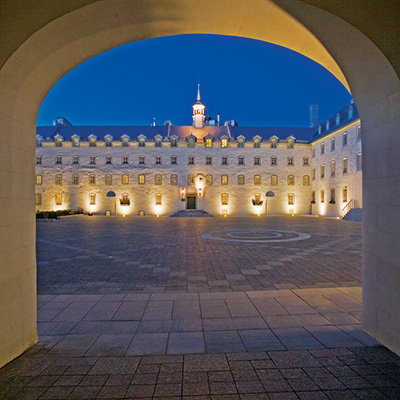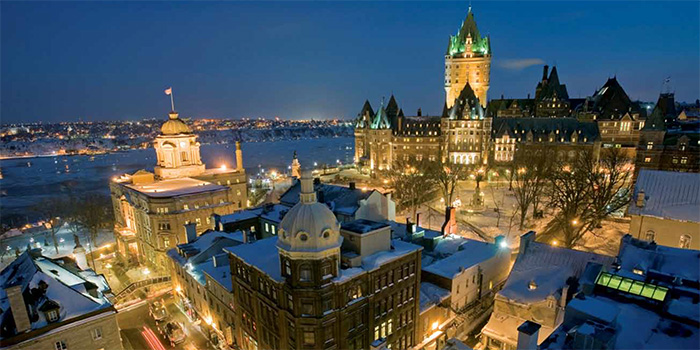Quebec, World Heritage City
Quebec City, included on UNESCO's World Heritage List in 1985 as North America's first urban ensemble, boasts a spectacular clifftop location overlooking the St. Lawrence River, fortifications, narrow, winding streets and historic buildings evoking four centuries of history. Québec City embodies a unique blend of tradition and modernity, and French and English influences, reflected in its urban landscape and architecture.
Mendel's guide, Québec, World Heritage City, offers a captivating introduction to the history of Québec City, its most important monuments, and the symbols and institutions of Old Québec. Here are just a few examples.
The Samuel de Champlain Monument
Samuel de Champlain, founder of Quebec City in 1608, was distinguished by his bold vision and unwavering determination. Initially driven by the hope of finding a route to the Orient via the St. Lawrence River, Champlain evolved into the conviction that Quebec could become the capital of a French colony in North America.
Despite his commercial responsibilities, he recognized the region's potential and engaged in relentless exploration, forging alliances with native peoples. His dedication is reflected in the many transatlantic voyages he undertakes to convince the French authorities to support his projects. As Cardinal Richelieu's lieutenant, Champlain laid the foundations of New France.
The monument erected in his honor in 1898, while embodying the legendary image of the great explorer, paradoxically reveals a lack of knowledge of his real appearance. Designed by Parisian artists, it bears witness to the influence of the French capital in the representation of this historic figure.
Place d'Armes
Place d'Armes, in the heart of Old Quebec, resonates with history and activity, bearing witness to the city's military past and its urban transformation over the centuries. Once a strategic assembly point for troops defending the city walls, today it is home to tourist attractions and iconic buildings such as the Château Frontenac and Holy Trinity Anglican Cathedral.
Designed in the 1640s under the aegis of Governor Montmagny, Place d'Armes followed a radial plan, with Fort Saint-Louis at its core, reflecting the desire to create an organized, defensible city. Streets radiating out from the central square are still visible in today's urban fabric, as are vestiges of the military architecture of the past, a reminder of Quebec's dynamic evolution through the centuries.
Chateau Frontenac
Since its inauguration in 1893, the Chateau Frontenac has become the emblematic symbol of Quebec City, representing not only the city but an entire country. Conceived and managed by William Cornelius Van Horne, president of Canadian Pacific, this majestic building embodied the railway company's ambition to dominate the luxury hotel market. Designed by American architect Bruce Price, the Chateau Frontenac adopts a romantic architecture inspired by European castles, with conical towers and a copper roof, contributing to the development of the château style that would influence architecture across Canada. Over the decades, the hotel has been enlarged and modernized by successive architects, while retaining Price's original spirit, bearing witness to the evolution of architecture and tourism in Canada.
The Chateau Frontenac also bears witness to the rise of Canadian Pacific, which not only built rail lines across the country, but also established a worldwide network of luxury liners linking Europe to Asia via Canada. This development attracted a wealthy clientele from abroad, contributing to the country's economic prosperity. The hotel was also the venue for historic meetings, including the Quebec Conferences of 1943 and 1944, when world leaders gathered to discuss Allied strategy during the Second World War. Today, the Chateau Frontenac remains an iconic and prestigious landmark, welcoming visitors from around the world and perpetuating Canada's architectural and historical heritage.
Dufferin Terrace
The Dufferin Terrace, with its panoramic view of Lower Town and the St. Lawrence River, is an urban jewel and one of the most beautiful spaces in North America, the result of the evolution of a site once occupied by the Château Saint-Louis, the governors' residence for two centuries. After the residence burned down in 1834, the terrace was opened to the public by decision of Governor General Lord Durham, and later renamed Dufferin Terrace in tribute to Lord Dufferin. This picturesque promenade features symbols representing Canada's founding peoples and is dotted with archaeological remains, including those of Fort Saint-Louis and Château Saint-Louis, discovered during excavations between 2005 and 2007. Discoveries include items such as an icehouse dating back to 1771, illustrating the ingenuity of food preservation techniques at the time, offering visitors a fascinating glimpse into Québec City's history.
The Cannons
The cannons in Quebec City, mostly British, were intended for the city's defense, and also included two Russian cannons, identified by the Romanov coat of arms, captured during the Crimean War in the 1850s. These war trophies symbolized victory, some being melted down to create medals such as the Victoria Cross. The seamless integration of Russian guns into British carriages stems from a collaboration between the Carron foundry in Scotland and Russia in the 18th century, epitomized by Charles Gascoigne, who, after settling in Russia, made a significant contribution to improving Russian artillery production. In addition, these British cannons had specific features, such as rings at the rear to attenuate recoil when fired and ensure their safety during transport at sea, giving rise to the expression "loose cannon" to describe an unpredictable individual.
The Governors' Garden
Originally a private garden laid out in the French style for governors, the Jardin des Gouverneurs in Quebec City became a public park after the governor's residence burned down in 1834. This green space, now managed by Parks Canada, is home to the monument to Wolfe and Montcalm, an obelisk erected in memory of the generals who died during the Battle of the Plains of Abraham in 1759. This unique monument symbolizes the union of the victors and the vanquished. The obelisk's cornerstone-laying ceremony in 1827 was marked by the presence of the battle's last veteran, James Thompson, a venerable man respected for his military contributions and his role in fortifying Quebec City.
The Jacquet House
The Maison Jacquet, now a restaurant, is the oldest house in Quebec City, with its original part dating from 1675 and enlarged in 1699, followed by an extension in 1820. Its steeply pitched roof reflects 17th-century architecture, while the section added in the 19th century boasts a more gently sloping roof. The building reflects advances in heating and insulation methods, enabling larger interior spaces. Once the home of renowned craftsmen such as Pierre-Noël Levasseur, sculptor of the Ursuline chapel, Jacquet House illustrates the architectural and social evolution of Québec's Upper Town in the 17th and 18th centuries.
The Ursuline Monastery
The Ursuline monastery, founded in 1639, is one of Quebec City's oldest educational establishments, still housing a renowned school for young girls. For centuries, the nuns lived cloistered lives, devoting their lives to God with little outside contact, although today the school enlivens the monastery's vast courtyards and wings. The Ursuline chapel, divided into a public section and one reserved for the nuns, contains artistic treasures and historical relics, such as the tomb of the Marquis de Montcalm. The Baroque altarpiece illustrates the saints' stories, while the museum preserves exquisite embroidery and artifacts recounting monastic life.
Street Layout
The winding streets and oddly shaped buildings that encircle the Ursuline property in Quebec City were largely influenced by a stream that has now disappeared, as revealed on a map dating from 1685. These ancient watercourses dictated the layout of streets and the boundaries of riverside properties, explaining the singular configuration of certain houses, one of which fans out backwards and another follows the curve of an ancient meander. This phenomenon illustrates how natural topography has often shaped the urban planning of historic cities such as Quebec City, which, with its winding streets and ancient European character, bears witness to its strategic past and vital link to the waterways, in keeping with urban traditions elsewhere in North America.
Holy Trinity Cathedral
Built between 1800 and 1804, Holy Trinity Cathedral is a masterpiece of British colonial architecture, being the first Anglican cathedral to be built outside the British Isles. Designed by British officers Captain William Hall and Major William Robe, the cathedral was inspired by the London church of Saint-Martin-in-the-Fields. Although sober in comparison, it bears witness to an adaptation to local constraints, as evidenced by the modification of the pediment to counter the rigors of winter. The harmonious proportions of the interior reflect a thorough knowledge of the principles of classical architecture. British officers, trained in a variety of disciplines, demonstrated their versatility in designing this remarkable edifice, illustrating the fusion between the British Empire and French-speaking Quebec. Interior ornaments such as stained-glass windows and liturgical silverware, as well as commemorative plaques recalling colonial history, enrich the cathedral's heritage, while details such as the royal and episcopal coats of arms embody the links between the Crown and the Church.
City Hall Square
City Hall Square, in the heart of Old Quebec, embodies the essence of early European public squares, providing a historic gathering place for the population. Bordered by iconic buildings such as Notre-Dame Basilica and City Hall, it bears witness to the interaction between religious and civil power. Once a vital public market, it was the center of commercial life, where residents procured provisions and exchanged news. Although the market disappeared in 1875, the square remains a lively meeting place where residents and workers cross paths, exchanging conversations and enjoying the performances of public entertainers, underlining the lively, social character of Old Quebec.
City Hall
Québec City's City Hall, erected between 1895 and 1896 on the site of the former Jesuit College founded in 1635, bears the vestiges of its historic past. Archaeological digs revealed the tombs of Jesuit priests and the foundations of the church demolished in 1807, while more recent discoveries have unearthed additional skeletons. Designed by architect Georges-Émile Tanguay, the town hall blends French and American influences, presenting a symmetrical façade with distinctive architectural elements, while retaining Jesuit symbols, including the IHS monogram, underscoring its rich historical heritage.
The Taschereau Monument
At the heart of Place de l'Hôtel-de-Ville stands a monument dedicated to Archbishop Elzéar-Alexandre Taschereau, Canada's first cardinal, erected in 1923 after an international competition and created by French sculptors André Vermare and Maxime Roisin. The bas-reliefs illustrating significant moments in Taschereau's life, such as his educational role at the Séminaire de Québec and Université Laval, his devotion to the sick during the typhus epidemic of 1848, and his commitment to devotion to the Blessed Sacrament, reflect his lasting influence. In addition, the monument takes on special significance because of the artists' subsequent contribution to the reconstruction of Notre-Dame de Québec after the devastating fire of 1922, symbolized by the recreation of the baldachin sculpted by François Baillairgé.
Notre-Dame de Québec
Notre-Dame de Québec, erected in 1647 and elevated to the status of the first Catholic cathedral north of Mexico in 1674, has played a central role in the religious history of North America. Despite the destruction caused by British bombing in 1759 and a devastating fire in 1922, the church has been rebuilt several times, retaining its importance as a cathedral and basilica. Renovations, carried out by architects and artists such as François Baillairgé and Thomas Baillairgé, have preserved the neoclassical architecture of the façade, as well as remarkable features such as the baldachin and altar. The Baillairgé family, notably Jean, François, Thomas and Charles, played a crucial role in the reconstruction and ornamentation of the church over the centuries. Notre-Dame de Québec also houses a rich collection of silverware, including a 17th-century chalice and paten, reflecting its long history and liturgical importance.
Seminary of Quebec
The Seminary of Quebec, founded in 1663 by François de Laval, is a major institution in New France. Initially established to train diocesan priests and establish parishes, the seminary grew over the centuries, expanding its role to include training young people for the priesthood and the founding of Université Laval in 1852. Despite changes such as the university's move to the suburb of Sainte-Foy in the 1950s, some parts of the seminary are still active, such as the School of Architecture. The seminary's architecture reflects the era of New France, while its chapels and relics bear witness to its spiritual importance. Today, the Seminary of Quebec preserves its history and heritage, while continuing to evolve to meet the needs of contemporary society.
Further Information
Quiz questions preview
-
Which United Nations agency included the historic district of Quebec City on its World Heritage List in 1985?
UNICEF | WHO | ILO | UNESCO -
Which major institution of New France was founded by François de Laval in 1663?
Sainte-Anne-de-Beaupré Basilica | Ursuline monastery | Our Lady of the Cape Shrine | Seminary of Quebec -
Which public boardwalk, opened in 1838, offers a breathtaking view of the city and the St. Lawrence River?
Jacques-Cartier Terrace | Champlain Terrace | Dufferin Terrace | Turcotte Terrace -
What site was created around 1640 as a parade ground and assembly point for troops?
Royal Gun Battery | Citadelle | Place d’Armes | Arsenal -
Which company, a symbol of tourism promotion in Canada, was behind the construction of the Chateau Frontenac?
Canadian Pacific | Waldorf Astoria | Canadian National | Hudson's Bay Company


